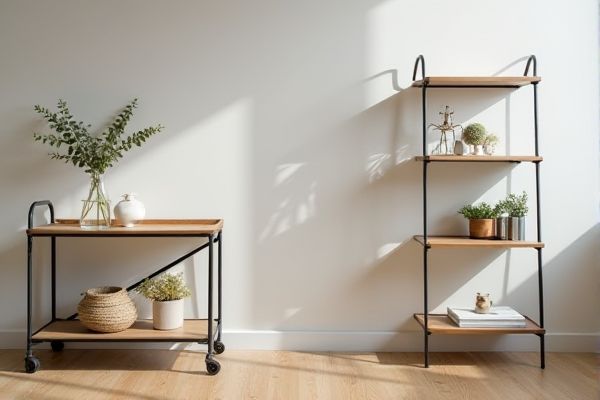
A rolling cart offers mobility and flexibility for organizing and transporting items, making it ideal for dynamic workspaces or frequent rearrangements. Discover how choosing between a rolling cart and a stationary shelf can impact your space efficiency and functionality by reading the full article.
Table of Comparison
| Feature | Rolling Cart | Stationary Shelf |
|---|---|---|
| Mobility | High - Easily moved to different locations | None - Fixed position |
| Space Efficiency | Flexible - Can be repositioned for space optimization | Permanent - Requires designated space |
| Load Capacity | Moderate - Limited by wheel and frame strength | High - Can support heavier weights |
| Setup | Minimal - Usually pre-assembled | Complex - May require installation |
| Use Cases | Ideal for dynamic environments and temporary storage | Best for permanent, organized storage |
| Durability | Moderate - Wear on wheels over time | High - Stable and robust |
| Cost | Generally lower upfront cost | Often higher due to size and materials |
Introduction to Rolling Carts and Stationary Shelves
Rolling carts offer mobility and flexibility for organizing and transporting items across various settings, featuring wheels for easy movement and adjustable shelves for versatile storage. Stationary shelves provide stable, fixed storage solutions ideal for maximizing space in offices, warehouses, or homes, with durable frames designed to hold heavier loads consistently. Both options serve distinct organizational needs, with rolling carts excelling in accessibility and stationary shelves in permanent, high-capacity storage.
Key Differences Between Rolling Carts and Stationary Shelves
Rolling carts offer mobility and flexibility, allowing easy transportation of items across different spaces, while stationary shelves provide stable, permanent storage solutions ideal for organizing items in fixed locations. Rolling carts typically feature wheels and lightweight frames for maneuverability, whereas stationary shelves are designed with sturdy construction to support heavier loads over time. The choice between the two depends on the need for portability versus consistent organization and weight capacity.
Advantages of Rolling Carts
Rolling carts offer superior mobility, allowing users to easily transport items across different locations within a workspace or home, which enhances efficiency and flexibility. Their compact design often includes multiple tiers or compartments, providing accessible storage without occupying permanent floor space like stationary shelves. Rolling carts also adapt well to dynamic environments, making them ideal for tasks requiring frequent reorganization or quick access to tools and supplies.
Benefits of Stationary Shelves
Stationary shelves provide enhanced stability and durability, making them ideal for storing heavy or fragile items securely. They maximize space efficiency by offering fixed, organized storage that maintains consistent accessibility. Their low maintenance and robust construction ensure long-term reliability in both commercial and residential settings.
Space Efficiency: Which is Better?
Rolling carts offer superior space efficiency by maximizing mobility and allowing flexible storage solutions in compact areas, ideal for environments with limited floor space or dynamic layouts. Stationary shelves provide stable, high-capacity storage but require fixed positioning, which may reduce adaptability and efficient use of irregular or constrained spaces. For optimizing space efficiency, rolling carts excel in multi-functional zones where space reconfiguration is frequent, whereas stationary shelves are best suited for designated storage areas with consistent inventory needs.
Mobility and Flexibility Comparison
Rolling carts offer superior mobility, allowing you to easily transport items between rooms or workstations, enhancing flexibility in dynamic environments. Stationary shelves provide stable, fixed storage ideal for organizing heavy or bulky items but lack the convenience of movement. Choosing between the two depends on whether your priority is frequent relocation or consistent, accessible storage.
Durability and Load Capacity
Rolling carts typically feature a sturdy construction designed to handle moderate to heavy loads while allowing mobility, often supporting weight capacities ranging from 150 to 500 pounds depending on materials and wheel quality. Stationary shelves, made from solid steel or reinforced wood, usually offer higher load capacities, sometimes exceeding 1,000 pounds per shelf, providing unmatched durability for long-term storage needs. Your choice should depend on whether mobility or maximum load capacity and stability are prioritized in your storage environment.
Organization and Accessibility Features
A rolling cart offers versatile organization with multiple tiers and compartments, allowing easy access to your items from different locations. Its mobility enhances accessibility by enabling quick relocation, making it ideal for dynamic spaces like kitchens or workshops. Stationary shelves provide stable, permanent storage with fixed sections that help categorize belongings efficiently but lack the convenience of portability for changing organizational needs.
Cost Considerations and Budget Insights
Rolling carts typically cost more upfront due to their mobility features and durable wheels, making them a flexible yet higher-investment option. Stationary shelves generally offer a more affordable solution for long-term storage without the added expense of moving components. Your budget will determine whether mobility or cost-efficiency holds greater priority in your storage planning.
Choosing the Best Option for Your Needs
Rolling carts offer mobility and flexibility, ideal for dynamic environments such as offices or kitchens where frequent access and repositioning are necessary. Stationary shelves provide sturdy, permanent storage solutions better suited for heavy items or spaces with limited movement, ensuring durability and stability. Assess your space constraints, item weight, and usage frequency to determine whether a portable or fixed storage unit aligns best with your functional requirements.
 homyna.com
homyna.com